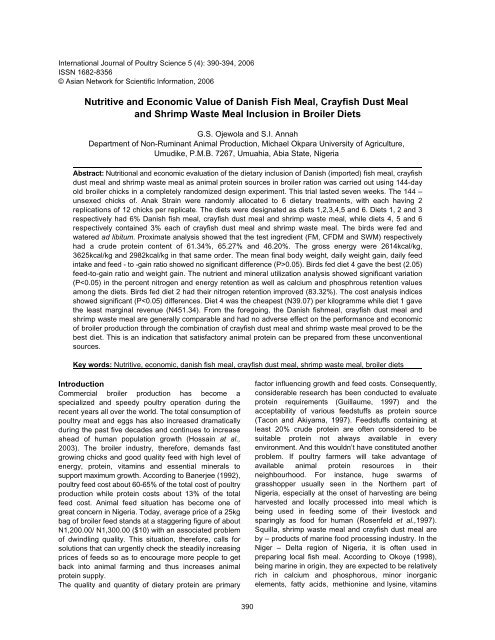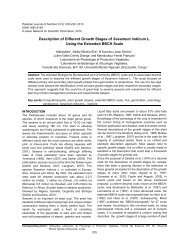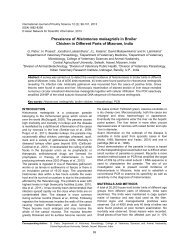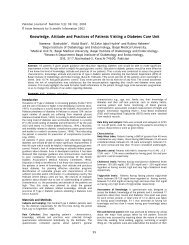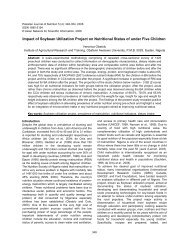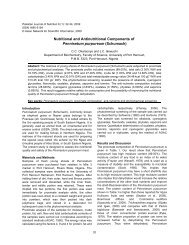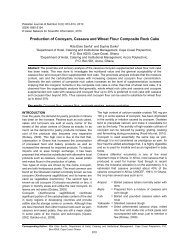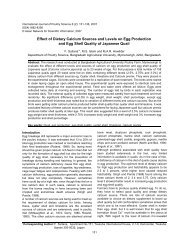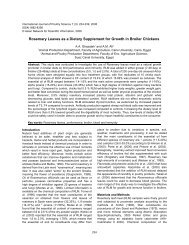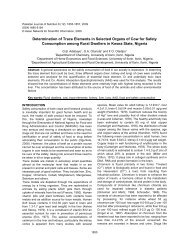Nutritive and Economic Value of Danish Fish Meal - Pakistan ...
Nutritive and Economic Value of Danish Fish Meal - Pakistan ...
Nutritive and Economic Value of Danish Fish Meal - Pakistan ...
You also want an ePaper? Increase the reach of your titles
YUMPU automatically turns print PDFs into web optimized ePapers that Google loves.
International Journal <strong>of</strong> Poultry Science 5 (4): 390-394, 2006<br />
ISSN 1682-8356<br />
© Asian Network for Scientific Information, 2006<br />
<strong>Nutritive</strong> <strong>and</strong> <strong>Economic</strong> <strong>Value</strong> <strong>of</strong> <strong>Danish</strong> <strong>Fish</strong> <strong>Meal</strong>, Crayfish Dust <strong>Meal</strong><br />
<strong>and</strong> Shrimp Waste <strong>Meal</strong> Inclusion in Broiler Diets<br />
G.S. Ojewola <strong>and</strong> S.I. Annah<br />
Department <strong>of</strong> Non-Ruminant Animal Production, Michael Okpara University <strong>of</strong> Agriculture,<br />
Umudike, P.M.B. 7267, Umuahia, Abia State, Nigeria<br />
Abstract: Nutritional <strong>and</strong> economic evaluation <strong>of</strong> the dietary inclusion <strong>of</strong> <strong>Danish</strong> (imported) fish meal, crayfish<br />
dust meal <strong>and</strong> shrimp waste meal as animal protein sources in broiler ration was carried out using 144-day<br />
old broiler chicks in a completely r<strong>and</strong>omized design experiment. This trial lasted seven weeks. The 144 –<br />
unsexed chicks <strong>of</strong>. Anak Strain were r<strong>and</strong>omly allocated to 6 dietary treatments, with each having 2<br />
replications <strong>of</strong> 12 chicks per replicate. The diets were designated as diets 1,2,3,4,5 <strong>and</strong> 6. Diets 1, 2 <strong>and</strong> 3<br />
respectively had 6% <strong>Danish</strong> fish meal, crayfish dust meal <strong>and</strong> shrimp waste meal, while diets 4, 5 <strong>and</strong> 6<br />
respectively contained 3% each <strong>of</strong> crayfish dust meal <strong>and</strong> shrimp waste meal. The birds were fed <strong>and</strong><br />
watered ad libitum. Proximate analysis showed that the test ingredient (FM, CFDM <strong>and</strong> SWM) respectively<br />
had a crude protein content <strong>of</strong> 61.34%, 65.27% <strong>and</strong> 46.20%. The gross energy were 2614kcal/kg,<br />
3625kcal/kg <strong>and</strong> 2982kcal/kg in that same order. The mean final body weight, daily weight gain, daily feed<br />
intake <strong>and</strong> feed - to -gain ratio showed no significant difference (P>0.05). Birds fed diet 4 gave the best (2.05)<br />
feed-to-gain ratio <strong>and</strong> weight gain. The nutrient <strong>and</strong> mineral utilization analysis showed significant variation<br />
(P
Ojewola <strong>and</strong> Annah: <strong>Danish</strong> <strong>Fish</strong> <strong>Meal</strong>, Crayfish Dust <strong>Meal</strong> <strong>and</strong> Shrimp Waste <strong>Meal</strong><br />
Table 1: Proximate composition <strong>of</strong> the test ingredients<br />
Measurement + (%) <strong>Danish</strong> Crayfish Shrimp<br />
<strong>Fish</strong> dust waste<br />
meal meal meal<br />
Crude protein 61.34 65.27 46.20<br />
Ether extract 6.94 5.00 6.21<br />
Crude fibre 0.00 2.23 2.07<br />
Ask 6.32 11.31 13.18<br />
Nitrogen free extract 15.72 11.91 22.57<br />
Dry matter 90.32 95.00 90.00<br />
Gross energy(kcal/kg) 2614.00 3625.00 2982.00.<br />
Table 2: Mineral composition <strong>of</strong> the test ingredients<br />
Measurement + (%) <strong>Danish</strong> Crayfish Shrimp<br />
<strong>Fish</strong> dust waste<br />
meal meal meal<br />
K N.D 1.80 1.21<br />
Na N.D 1.50 1.34<br />
Ca 0.3 0.89 0.98<br />
P 0.2 1.19 0.42<br />
Mg N.D 0.30 0.29<br />
N.D - Not determined.<br />
<strong>and</strong> unidentified growth factors. It is on the basis <strong>of</strong> this<br />
that this trial was conducted to comparatively evaluate<br />
the performance, nutrient utilization <strong>and</strong> economics <strong>of</strong><br />
production <strong>of</strong> broiler chickens fed <strong>Danish</strong> (imported) fish<br />
meal, crayfish dust meal <strong>and</strong> shrimp waste meal in an<br />
attempt to increase the animal protein resource pool<br />
from which poultry farmers can source from.<br />
Materials <strong>and</strong> Methods<br />
Procurement <strong>and</strong> Processing <strong>of</strong> the test ingredients:<br />
Fresh samples <strong>of</strong> the species litpenaeus vannemci<br />
(shrimp) was purchased from the local beach market in<br />
Calabar, Cross River State, Nigeria. Their heads,<br />
appendages <strong>and</strong> exoskeleton were extracted from the<br />
tissues. It was boiled to reduce moisture content <strong>and</strong><br />
then sundried under intense sun for 120 hours. The<br />
crayfish dust was purchased dried from the same local<br />
market. They were then ground separately using a<br />
commercial though, locally made blender. <strong>Danish</strong><br />
fishmeal was purchased from Ibadan, Oyo State,<br />
Nigeria. Each <strong>of</strong> the test ingredients was then put into a<br />
labeled jute bag.<br />
Experimental diets: A total <strong>of</strong> six diets having percent<br />
crude protein which ranged between 20.86% <strong>and</strong><br />
22.01% <strong>and</strong> caloric densities <strong>of</strong> 2989.6 <strong>and</strong><br />
3035.50kcal/kg were formulated as shown in Table 3.<br />
Maize was the major source <strong>of</strong> energy while <strong>Danish</strong> fish<br />
meal, Soybean meal, shrimp waste meal <strong>and</strong> crayfish<br />
dust meal were the major protein sources. The diets<br />
were fortified with synthetic amino acid, such as lysine<br />
<strong>and</strong> methionine. Diet 1, designated the control,<br />
contained no shrimp waste meal <strong>and</strong> or crayfish dust<br />
meal. Diets 2 (100% crayfish dust meal), 3 (100%<br />
shrimp waste meal) 4 (50% crayfish dust meal <strong>and</strong> 50%<br />
shrimp waste meal), 5 (50% <strong>Danish</strong> fish meal <strong>and</strong> 50%<br />
crayfish dust meal) <strong>and</strong> 6 (50 <strong>Danish</strong> fishmeal <strong>and</strong> 50%<br />
shrimp Waste meal).<br />
Experimental birds, management <strong>and</strong> design: A total <strong>of</strong><br />
one hundred <strong>and</strong> forty-four (144) day-old unsexed<br />
broilers <strong>of</strong> the Anak strain were procured from Obasanjo<br />
Farms limited, Ota, Ogun State. On arrival, the chicks<br />
were r<strong>and</strong>omly allocated to each diet <strong>and</strong> replicated<br />
twice giving 12 chicks per replicate. The initial weights <strong>of</strong><br />
the chicks were measured <strong>and</strong> antistress was<br />
administered. The chicks were brooded using lantern<br />
<strong>and</strong> kerosene store while electric bulbs were used in<br />
providing artificial light at night. Vaccination against<br />
Newcastle disease was administered to the birds’<br />
intraoccular at day-old while lasota vaccine was<br />
th<br />
administered on the 16 day. Keproceryl was given to<br />
the birds to protect them against Chronic Respiratory<br />
Diseases (CRD). Coccidiostat (Pentacox) was<br />
th th<br />
administered between the 4 <strong>and</strong> 5 week.<br />
Data collection: The experimental design was<br />
completely R<strong>and</strong>omized Design (CRD). Initial live<br />
weights <strong>of</strong> the birds were taken on group basis at the<br />
beginning <strong>of</strong> the experiment. Subsequent weighing <strong>of</strong><br />
birds was done weekly <strong>and</strong> on individual basis. Weight<br />
gain was obtained by subtracting the initial live weight<br />
from the final live weight. Feed intake was determined by<br />
subtracting the weight <strong>of</strong> the left over from the feed<br />
<strong>of</strong>fered to the birds the previous morning on daily basis.<br />
Feed conversion ratio was determined by dividing feed<br />
intake by weight gain.<br />
Nutrient retention trial: At six weeks <strong>of</strong> age, digestibility<br />
trial was carried out. Two birds (one per replicate)<br />
closest to the mean weight <strong>of</strong> the birds per treatment<br />
were r<strong>and</strong>omly selected <strong>and</strong> transferred to metabolic<br />
cages <strong>and</strong> in individual compartments, each bird was<br />
housed. They were fed test diets according to their<br />
experimental diet groups for 4 days acclimatization<br />
period followed by feeding <strong>of</strong> a measured quality <strong>of</strong> feed<br />
(200g) for 3 days. Droppings were collected for those 3<br />
days by means <strong>of</strong> clean trays placed under the cages.<br />
Samples <strong>of</strong> the droppings were collected <strong>and</strong> oven dried<br />
oC<br />
at 90 , bulked, <strong>and</strong> representative samples <strong>of</strong> the<br />
droppings, feed <strong>and</strong> test ingredients were taken for<br />
proximate <strong>and</strong> mineral analysis according to A.O.A.C<br />
(1990). Estimation <strong>of</strong> the digestible nutrient was<br />
according to McDonald et al. (2000) as shown below:<br />
Nutrient intake - Nutrient in feaces<br />
%Digestibility = ------------------------ X 100<br />
Nutrient intake<br />
<strong>Economic</strong> analysis: The cost <strong>of</strong> dietary ingredients<br />
(N/kg) were recorded <strong>and</strong> used to calculate the cost/kg<br />
<strong>of</strong> each diet. Feed intake per bird per treatment for the<br />
391
Ojewola <strong>and</strong> Annah: <strong>Danish</strong> <strong>Fish</strong> <strong>Meal</strong>, Crayfish Dust <strong>Meal</strong> <strong>and</strong> Shrimp Waste <strong>Meal</strong><br />
Table 3: Composition <strong>of</strong> the experimental diets<br />
Diets Ingredients (%)<br />
------------------------------------------------------------------------------------------------------------------------------<br />
1 2 3 4 5 6<br />
Yellow maize 60.00 60.00 60.00 60.00 60.00 60.00<br />
Soyabean meal 28.80 28.80 28.80 28.80 28.80 28.80<br />
<strong>Fish</strong> meal (<strong>Danish</strong>) 6.00 0.00 0.99 0.00 3.00 3.00<br />
Crayfish dust meal 0.00 6.00 0.00 3.00 3.00 0.00<br />
Shrimp waste meal 0.00 0.00 6.00 3.00 0.00 3.00<br />
Bone meal 3.00 3.00 3.00 3.00 3.00 3.00<br />
Oyster shell 1.50 1.50 1.50 1.50 1.50 1.50<br />
Salt 0.25 0.25 0.25 0.25 0.25 0.25<br />
Vit Min. Premix 0.25 0.25 0.25 0.25 0.25 0.25<br />
Methionine 0.10 O.10 0.10 0.10 0.10 0.10<br />
Lysine 0.10 O.10 0.10 0.10 0.10 0.10<br />
Total 100.00 100.00 100.00 100.00 100.00 100.00<br />
Calculated analysis:<br />
Crude protein (%) 21.69 22.01 20.86 21.44 21.85 21.28<br />
Metabolizable Energy (Kcal/kg) 2989.60 3035.50 2996.92 3016.21 3012.55 2993.26<br />
Calrie: Protein ratio 138 138 144 141 138 141<br />
Determined Proximate analysis:<br />
Crude protein (%) 22.92 23.62 23.01 23.36 23.01 22.66<br />
Ether extract (%) 4.20 3.72 3.70 3.64 4.17 4.36<br />
Crude fibre (%) 3.88 3.73 4.04 3.71 3.97 4.03<br />
Ash (%) 7.74 7.77 8.22 8.51 8.60 8.76<br />
NFE (%) 51.47 52.43 52.28 50.93 51.10 51.30<br />
Cry matter (%) 90.20 91.30 91.24 90.15 10.84 91.10<br />
Gross energy (Kcal/kg) 3989 4129 4131 4020 4181 4170<br />
Determined Mineral analysis<br />
Potassium (%) 1.14 1.21 1.19 1.13 1.30 1.21<br />
Sodium (%) 0.83 0.87 0.90 0.99 0.82 0.91<br />
Manganese (%) 0.33 0.39 0.36 0.37 0.52 0.41<br />
Calcium (%) 1.00 1.00 1.01 0.99 1.00 1.04<br />
Phosphorous (%) 0.60 0.64 0.70 0.64 0.70 0.72<br />
Vitamin Mineral premix provided (Per kg <strong>of</strong> diet): Vit A I1500IU, Vit. D 3, 1600IU; Rib<strong>of</strong>favin, 9.9mg; Biotin, 0.25; Pantothenic acid,<br />
11.0mg; Vitamin K, 3.0mg; Vit B2,<br />
2.5MG; Vit. B6, 0.3mg; Vit. B12, 8.0mg; Nicotinic acid, 8.0mg; Iron, 5.0mg; Manganese, 10.0mg;<br />
Zinc, 4.5mg; Cobalt, 0.02mg; Selenium, 0.01mg.<br />
experimental period was used to multiply the cost/kg<br />
feed to obtain the cost <strong>of</strong> feed was calculated using the<br />
procedure <strong>of</strong> Sonaiya et al. (1986) <strong>and</strong> Ukachukwu <strong>and</strong><br />
Anugwa (1995), which involved taken the product <strong>of</strong><br />
cost/kg feed <strong>and</strong> feed to-gain ratio <strong>of</strong> consuming such<br />
diets.<br />
1 Cost <strong>of</strong> production = Cost/kg weight gain x mean<br />
weight gain<br />
2 Revenue = Price (N/kg) Meat x Mean weight gain<br />
3 Gross Margin = Revenue - Cost <strong>of</strong> production<br />
Statistical analysis: Data were subjected to analysis <strong>of</strong><br />
variance <strong>of</strong> a completely r<strong>and</strong>omized design in this<br />
study. When analysis <strong>of</strong> variance indicated a significant<br />
treatment effect, Duncan’s multiple range test was used<br />
to differentiate the means using procedures described<br />
by Steel <strong>and</strong> Torrie (1980).<br />
Results <strong>and</strong> Discussion<br />
The proximate <strong>and</strong> mineral composition <strong>of</strong> the test<br />
ingredients are shown in Table 1 <strong>and</strong> 2 respectively. The<br />
differences in the values obtained could be due to the<br />
sources <strong>of</strong> the test ingredients, processing techniques,<br />
storage <strong>and</strong> some other hiding factors.<br />
The results <strong>of</strong> the body weight, body weight gain <strong>and</strong><br />
feed conversion ratio <strong>of</strong> broilers as affected by the dietary<br />
treatments are summarized in Table 4. There was no<br />
significant difference (P>0.05) among the treatment<br />
means for all the parameters considered. Broilers fed<br />
combination <strong>of</strong> fish meal <strong>and</strong> crayfish dust meal (Diet 5)<br />
consumed the highest quantity <strong>of</strong> feed (82.23g) while<br />
those fed 6% <strong>Danish</strong> fish meal only (Diet 1) consumed<br />
the least (74.5g). Olomu (1995) reported that crayfish is<br />
very tasty; the combination <strong>of</strong> crayfish with <strong>Danish</strong> fish<br />
meal in equal proportion could have enhanced the<br />
palatability <strong>of</strong> this diet, which inturn improved the intake.<br />
In overall performance, birds fed combination <strong>of</strong> crayfish<br />
dust meal (3%) <strong>and</strong> shrimp waste means (3%) (diet 4)<br />
gave the best weight gain (1875.30g) <strong>and</strong> better feed<br />
conversion (2.05). Diet 1 had the least weight gain<br />
(1600.00g) <strong>and</strong> second best feed conversion (2.16).<br />
This suggests that at low levels, chitin has a growth<br />
promoting effect by producing glucosamine during its<br />
digestion through chitinase enzyme secreted by<br />
intestinal bacteria (Ramanch<strong>and</strong>ran Nair et al., 1987).<br />
Similar observation had been documented (Spreen et<br />
al., 1984). They observed that chitinous material at lower<br />
392
Ojewola <strong>and</strong> Annah: <strong>Danish</strong> <strong>Fish</strong> <strong>Meal</strong>, Crayfish Dust <strong>Meal</strong> <strong>and</strong> Shrimp Waste <strong>Meal</strong><br />
Table 4: Performance characteristics <strong>of</strong> the broiler birds fed danish fishmenl, shrimp waste meal <strong>and</strong> Crayfish dust meal (0-49 days).<br />
Performance index<br />
Diets<br />
(g/b/d) --------------------------------------------------------------------------------------------------------------------------------------------------------------<br />
1 2 3 4 5 6 SED<br />
Mean initial body weight 49.69 49.50 50.00 49.70 49.68 49.75 0.00<br />
Mean final body weigh 1650 1900.00 1725.00 1925.00 1800.00 1850.00 128.00<br />
Mean body weight gain 1600 1850.50 1675.00 1875.30 1750.30 1800.00 128.00<br />
Mean daily weight gain 32.66 37.77 34/18 38.27 35.72 36.74 261.00<br />
Mean total feed intake 3651.6 4017.30 3697.50 3821.00 4029.30 3932.6 218.00<br />
Mean daily feed intake 74.52 81.98 57.46 77.98 82.23 80.25 4.49<br />
Feed-to-gain ratio 2.29 2.16 2.20 2.05 2.30 2.18 0.13<br />
Table 5: Nutrient utilization <strong>of</strong> the different animal protein sources by the experimental birds<br />
Parameter (%)<br />
Diets<br />
---------------------------------------------------------------------------------------------------------------------------------------------<br />
1 2 3 4 5 6 SED<br />
Nitrogen retained<br />
b<br />
77.65<br />
a<br />
83.32<br />
b<br />
77.82<br />
b<br />
79.56<br />
b<br />
78.39<br />
b<br />
78.21 0.94<br />
Crude fibre digestibility<br />
cd<br />
7.80<br />
a<br />
27.47<br />
bc<br />
11.78<br />
d<br />
1.50<br />
cd<br />
18.51<br />
cd<br />
7.46 4.05<br />
Fat digestibility<br />
c<br />
86.93<br />
a<br />
89.74<br />
bc<br />
8753<br />
c<br />
86.79<br />
ab<br />
88.65<br />
bc<br />
87.83 0.56<br />
Ash digestibility<br />
c<br />
34.47<br />
a<br />
51.87<br />
b<br />
42.88<br />
a<br />
52.64<br />
ab<br />
46/79<br />
ab<br />
48.18 2.68<br />
Energy retained<br />
c<br />
91.14<br />
a<br />
93.65<br />
ab<br />
91.96<br />
b<br />
92.01<br />
b<br />
92.32<br />
b<br />
92.01 0.35<br />
Abcd - means within a row with different superscripts are significantly different (P
Ojewola <strong>and</strong> Annah: <strong>Danish</strong> <strong>Fish</strong> <strong>Meal</strong>, Crayfish Dust <strong>Meal</strong> <strong>and</strong> Shrimp Waste <strong>Meal</strong><br />
broiler chicken fed the varying dietary treatments. The<br />
cost per kilogramme feed consumed <strong>and</strong> cost per total<br />
feed consumed (N) during the period were significantly<br />
influenced (P


